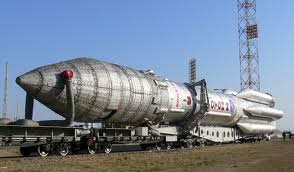The Proton-M rocket that is loaded with the British telecommunications satellite called Immarsat-5F1 was launched int space on Sunday from the Russian space port of Baikonur. The news came from a press release of the Khrunichev Space Research and Production Center. “The launch of the telecommunications satellite Inmarsat-5F1 is scheduled at 16:12 Moscow time on Sunday, December 8, from the spaceport Baikonur,” said the statement, in part. There is already a plan in place for launching and setting up the orbiting satellite, and it will be launched according to that scheme that has been tested previously.
 There are three beginning stages of the Proton-M rocket. They will allow the next stage rocket to be placed into a suborbital trajectory. That rocket is actually carrying the satellite, called Briz-M. Then, the satellite will use its own engine to get into geostationary orbit. Basically, the main rocket is just piggybacking on the first, the Proton-M. Once it has reached its destination, it will detach itself from the other rocket, just like a hitchhiker that has reached its destination, and carry the satellite the rest of the way. The telecommunications satellite is set to be deployed at 63 East longitude. It will take about 15 hours for the satellite to detach from the upper stage rocket.
There are three beginning stages of the Proton-M rocket. They will allow the next stage rocket to be placed into a suborbital trajectory. That rocket is actually carrying the satellite, called Briz-M. Then, the satellite will use its own engine to get into geostationary orbit. Basically, the main rocket is just piggybacking on the first, the Proton-M. Once it has reached its destination, it will detach itself from the other rocket, just like a hitchhiker that has reached its destination, and carry the satellite the rest of the way. The telecommunications satellite is set to be deployed at 63 East longitude. It will take about 15 hours for the satellite to detach from the upper stage rocket.
The Boeing satellite Inmarsat-5F1 is around six tons, and the Proton-M launch vehicle is a version of the rocket Proton-M rocket, albeit an upgraded version. The first time that this rocket was launched with the upper stage rocket in place was on April 7th, 2001. The program that is conducting the launhc, International Launch Services Inc., or abbreviated I.L.S. Is a joint venture between the United States and the Russian government.








